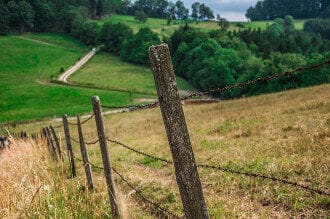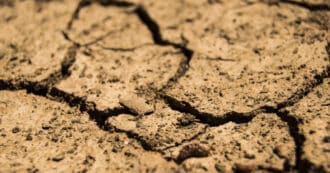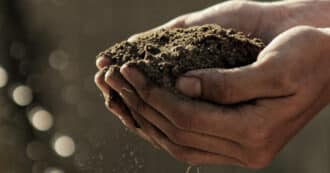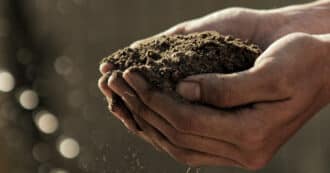By Harry Cooper – If you’ve ever been by a steep hill and seen slanted fence posts or tilted signs the culprit may be soil creep. Soil creep is the process of soil and other surface material slowly moving downhill when on a steep enough slope.
This process happens at an imperceptibly slow rate. However, the affects of soil creep can be seen in trees and fences being slanted over time, and the surface of these slopes having a rippling texture.
The main driving factor behind soil creep is gravity whereby the pressure from gravity pushes down on soil particles and slowly forces them downhill. However, this process is aided by several other natural forces such as rain and freezing temperatures which help soil in its downslope movement through slope wash and frost heaving.
What is Soil Creep?
Soil creep is a type of mass movement. Mass movement is a term used to describe a specific type of erosion in which dirt, rocks, and other surface material is moved down a slope by gravity.
There are many different types of mass movements. Some occur suddenly and rapidly such as rock falls and landslides, where large amounts of rock and earth quickly move downhill. Others are less volatile such as earthflows, where mud and debris flow downslope as a viscous fluid after heavy rain. However the slowest type of mass movement is soil creep, which occurs as gravity gradually pushes down on soil overtime, slowly moving it downhill.
How Does Soil Creep Work?
While soil creep relies on gravity to push soil downslope there are several conditions that need to be met that help gravity move the soil. Firstly, the ground must be at a steep enough angle in order for gravity to have any affect on the soil; the steeper the slope, the faster the soil will move. Another factor is how moist the soil is; water in the soil acts as a lubricant that helps the soil move faster. In addition to these conditions there are a handful of other factors that can move soil creep along.
Phenomenon Affecting Soil Creep
One of these factors is a phenomenon called frost heaving. Frost heaving is a process that involves the water in the soil freezing and melting, aiding in the gradual downslope movement of soil. This occurs as water in the soil freezes and expands, this forces surface soil grains upward, making them perpendicular to the sloped ground; then as the ice melts, the soil particles are forced directly downwards by gravity, resulting in a slight downhill movement every time soil freezes and melts.
Another phenomenon that works to move soil downhill is rain splash. Rain splash occurs as rain drops dislodge surface soil and sand particles upon impact and cause them to fall downhill. Not only does rain directly move soil downslope through rain splash, but rain also works to moisten the soil, making it easier for it fall downhill.
Effects of Soil Creep
While soil creep is a slow imperceptible phenomenon, the effects of it can still be seen on the steep slopes where it occurs. One such affect is the tilting of signs, poles, and fence posts. This is a result of such objects being staked deep into the ground. As surface soils are more susceptible to factors affecting creep such as moisture and frost wedging, soils towards the surface tend to move downhill faster than deeper ones. Therefore the faster creeping top soils push the signs and posts at an angle, tilting them downslope.
Another effect of soil creep is its ability to damage infrastructure. Roads and buildings built on hillsides susceptible to soil creep will often find themselves with cracked pavement or unstable foundations. This is because while soil creep may be a slow gradual force, it is still a very strong one. While it may take a while for any damages to show, infrastructure built on top of creeping soil is prone to be damaged overtime by the slow moving force.
While soil creep and landslides are considered to different types of mass movements, it is thought that soil creep can lead to some landslides. A study out of Japan found that soil creep helps build up soil in places where landslides could occur. As more and more soil builds up at these points, the more tension there is. These points of tension eventually release, causing debris flows and landslides.
Preventing Soil Creep
While soil creep is a process that occurs naturally on steep hills, it can still be harmful to human infrastructure, and a hassle to anyone building on a steep surface. Luckily there is an easy and natural way to prevent soil creep almost anywhere, planting trees and other plants.
The more plants a surface has on it, the more roots there are in the soil. These roots help keep the soil in place and prevent it from moving. Not only does stabilizing the soil with root systems slow down soil creep, but it also prevents all kinds of erosion.
Soil Creep and Religion
The Bahai Shrine and Gardens is the world headquarters of the Bahai faith and is located in Haifa, Israel. Because the Bahai Shrine is located on a slope, it was in danger of soil creep, and nobody wanted to see this sacred shrine sliding down the mountain. Therefore, it was intentionally designed with something called “Neoloy® Tough Cell stabilization,” which “were installed on the compacted slope at each of the 19 terraced gardens, where they create a stable soil mass via soil-root interlock. The Tough Cells confine the soil and minimize the movement of soil particles as well as the impact of rain drops and runoff.”
Building the Bahai Shrine and Garden in a manner that avoids soil creep is an impressive feat, and the shrine and garden themselves are no less impressive. Our religious buildings can be beautiful models for sustainable architecture. Let’s use them to point the way to a better, more sustainable future.
* Featured image source







